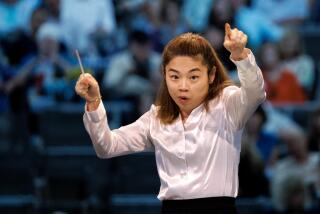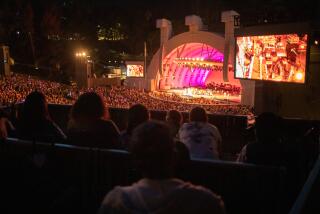‘Swan Lake’ Scenes Take Flight at Bowl’s Tchaikovsky Program
From its first, reportedly dreadful production at Moscow’s Bolshoi Theatre in 1877 to its latest, reportedly dreadful production by the same company, “Swan Lake” has always been a hit with audiences, if with no one else.
Even danced outdoors on a narrow margin of stage at the Hollywood Bowl--in front of the orchestra, with no scenery or atmospheric lighting to suggest the special world it creates--something of the ballet’s inspired blend of formal 19th century conventions and deep Romantic expression stirs the imagination.
So although the San Francisco Ballet performances of Act 2 weren’t ideal on Friday and Saturday, this component of the Bowl’s annual “Tchaikovsky Spectacular” belongs in a different category than the kitsch-fireworks of the “1812 Overture” or the workmanlike playing of the Bowl Orchestra in everything from the brooding “Romeo and Juliet” Fantasy-Overture to the perky “Nutcracker” Russian dance.
Based on the 1894 Ivanov version, Helgi Tomasson’s “Swan Lake” choreography relegates male virtuosity to an opening solo by a melodramatic and rather desperate Rothbart in a seaweed cape: Jorge Esquivel at both performances. Otherwise, his staging focuses on the 24-member corps, with Odette a projection of their refined lyrical style and Siegfried a living demonstration of how easy it is to fall under their spell.
Vadim Solomakha partnered ardently on Friday and Roman Rykine mimed with superb nobility the following night, but Tomasson so drastically undercuts the dramatic values of “Swan Lake” that it’s ridiculous when Odette begs Siegfried not to shoot the swans; this is not the kind of guy who’d ever fire a crossbow at a ballerina.
Exquisitely proportioned and supremely fluid, Yuan Yuan Tan (Friday) moved so quickly through Odette’s choreography that its major thematic statements--particularly the arabesque as key motif--never acquired the proper weight. In contrast, Tina LeBlanc (Saturday) effectively dramatized internal issues of the role--especially those of balance and velocity--but is not as ideally proportioned for pure classicism.
Playing formal abstractions rather than real characters, Tan and Solomakha emotionally connected within the music while LeBlanc and Rykine seemed to emerge and interact as distinctive individuals. Both partnerships benefited from the violin playing of concertmaster Bruce Dukov in the pas de deux, though the Bowl sound system often minimizes the strings.
*
Whether accompanying a ballet or launching a fireworks display, conductor John Mauceri brings no sense of propulsion to Tchaikovsky’s music, and his tendency to approach a work as a collage of effects--ignoring the possibility of an interpretive through line--can make you aware of how often this composer repeats himself.
But at least Mauceri is no longer guilty of turning the slippery opening section of “Romeo and Juliet” into a jumble of theme-scraps. The contrasts within the music are now carefully delineated and strongly projected in the playing.
Similarly, the successive buildups of tension in the “1812 Overture” were attended to with touching concern--as if musicianship alone is the key to audience satisfaction here rather than the varied showers of sparks overhead (courtesy of PyroSpectaculars) and the arrival, via hydraulic lift, of the USC Trojan Marching Band in full Homeric regalia.
More to Read
The biggest entertainment stories
Get our big stories about Hollywood, film, television, music, arts, culture and more right in your inbox as soon as they publish.
You may occasionally receive promotional content from the Los Angeles Times.










